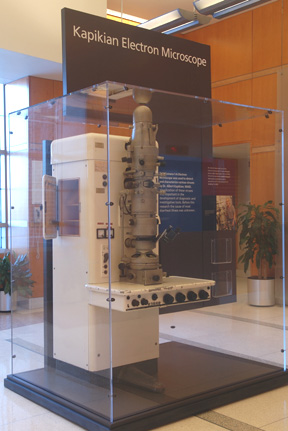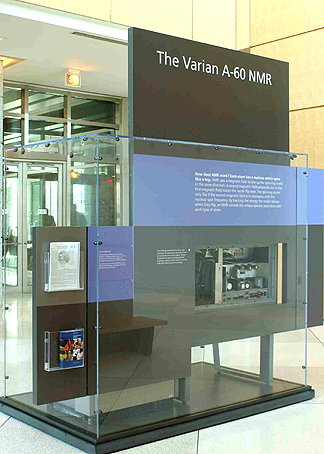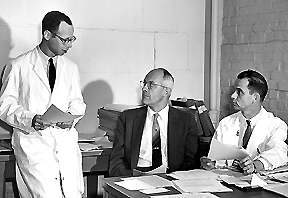 |
|
Siemens 1-A Electron Microscope |
 |
|
Varian
A-60 NMR
|
The
Past is Prologue
INSTRUMENTS
OF THE '60S
AND BEYOND
The NIH Stetten Museum and the Office of NIH History announce the display of two 1960s-era scientific instruments and the cutting-edge research for which they were used. The exhibit is sponsored by the OD Office of Communications and Public Liaison.
The Siemens 1-A Electron Microscope now on display in the lobby of Building 50 remained in use at NIH for over four decades. Albert Kapikian, NIAID, utilized immune electron microscopy to detect viruses. Specifically, he discovered and visualized Norwalk virus particles—known for striking cruise ships. This was the first time a virus was linked to diarrheal illness. NIH researchers also used this microscope to detect and characterize hepatitis A and hepatitis C, as well as to visualize human rotavirus.
Kapikian will describe his research on Tuesday, June 28, 1:00 p.m., in the Bldg. 50 lobby conference room.
The Varian A-60 NMR (nuclear magnetic resonance) spectrophotometer on display in the Natcher lobby is an example of the first low-cost, user-friendly instrument of its kind. It used powerful magnetic fields to line up the nuclei of atoms in the same direction and then flip them over. By tracing the energy the nuclei released when they flipped, the machine could record the unique spectra associated with each type of atom. The NMR led to the development of magnetic resonance imaging and the visualization of large molecules such as proteins. The display showcases the brain development research of Jay Giedd, NIMH, and the study in Adriaan Bax’s NIDDK laboratory of how large proteins move and function, with emphasis on immunodeficiency viruses.
NIDDK scientist emeritus Edwin Becker will speak on the history of NMR at the NIH on Tuesday, May 24, 1:00 p.m., in the Natcher Balcony A conference room.
—Michele Lyons, Curator, NIH Stetten Museum
The
Past is Prologue
APPROACHING
THE MIND IN THE '50S
AND BEYOND
The Office of NIH History, NIMH, and NINDS announce the publication of Mind, Brain, Body, and Behavior: Foundations of Neuroscience and Behavioral Research at the National Institutes of Health (Ingrid G. Farreras, Caroline Hannaway, and Victoria A. Harden, eds. Amsterdam: IOS Press, 2004).
This book emanated from a symposium, "NIMH and NINDB Intramural Research in the 1950s," held at NIH April 11, 2003, to recapture the historic work of both institutes’ intramural programs during their first decade of research at the NIH—a time when they shared a joint intramural basic research program.
Symposium participants donated historical photographs, correspondence, unpublished documents, laboratory notebooks, and other items from this time period to the Office of NIH History archives.
Author Ingrid Farreras, a Stetten Memorial fellow, supplemented the early history of the two institutes and detailed analysis of their joint program with extensive photographs and appendices that serve as references to who was in which laboratory when. Because NIH did not keep these records, she had to reconstruct the labs painstakingly via phone books, unpublished annual reports, and other sources.
Senior intramural scientists wrote firsthand accounts of their memories of the various labs and branches of the joint intramural program, and current NINDS director Story Landis traced the evolution of the research over the decades.
A major aim of this volume, say its editors, is to spur NIH scientists and administrators to collect, preserve, and donate archival materials to the Office of NIH History and the NLM.

